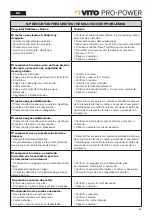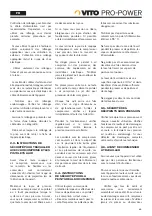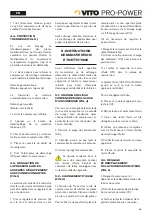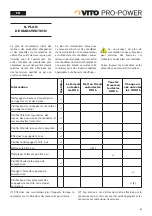
EN
37
works correctly, pull on the attached
ring. The air will be released loudly.
Then, loosen the ring.
4.4 - THERMAL PROTECTION
(FIG. H)
When there are obstructions or
damages in the moving/rotating parts,
the temperature increases and the
thermal protection is activated.
There are two options to turn the
compressor back on: automatic or
manual reset of the thermal protection.
Automatic reset:
(Button pressed and turned to the left)
The thermostat resets automatically
without intervention;
Manual reset:
(Button turned to the right)
1. Allow the compressor to cool down;
2. Open the contactor connections box
(7);
3. Press the contactor’s thermal button
(30);
If the thermal button doesn’t unclasp,
means the cooling process wasn’t
enough;
4. Insert the connections box cover;
5. Pull the power switch to turn the
compressor on (17);
4.5 - REGULATING THE
PRESSURE IN THE OUTLET
VALVES WITH QUICK
CONNECTION (FIG. I)
The compressed air outlet pressure in
the valves with quick connection can
be adjusted through the outlet pressure
regulator.
1. Pull the pressure regulator (6) up
and rotate it clockwise to increase
and counterclockwise to decrease the
outlet pressure;
After each use, untighten the
condensate purging screw to drain the
pressure regulator.
5. MAINTENANCE
AND CLEANING
INSTRUCTIONS
Make sure that the compressor is
disconnected from the electrical supply
before carrying any maintenance or
cleaning work.
5.1 - DRAINING
THE CONDENSED WATER OFF
THE COMPRESSED AIR TANK
(FIG. J)
To ensure the equipment’s long
lifespan it is recommended to drain
the condensed water after each use,
essentially when the compressor is
used in damp environments.
1. Loosen the tank’s condensates drain
(26);
2. Wait until it drains completely;
3. Tighten the condensates drain;
The condensed liquid inside the
compressed air tank contains
oil.
5.2 - REPLACING THE OIL
(FIG. K)
The oil inside the compressor unit
is intended to lubricate the parts in
constant friction, avoiding their wear
and overheat.
To check the oil level, place the
compressor over a plain and horizontal
surface. The oil level must be above the
red mark on the oil level display (24).
To adjust the oil level:
1. Disconnect the compressor from the
electrical supply;
2. Use a tool or loosen the condensates
drain (26) to depressurize;
3. Untighten the oil crankcase cover
(23) in the compression pump;
4. Add oil (SAE 30 or 15W40) until it
reaches the right level;
To replace the oil:
5. Put a basin under the purging screw
(31);
6. Remove the screw and empty the
tank;
7. After draining the oil, place and
tighten the screw;
8. Use a funnel and fill with new oil
through the opening;
9. Check the oil level and adjust until it
reaches the right level;
10. Place and tighten the oil crankcase
cover;
5.3 - REGULATING
AND REPLACING THE DRIVE
BELT (FIG. L)
1. Disconnect the compressor from the
electrical supply;
2. Remove the drive belt protection
(9):
a) Rotate all protection grid fixations
with a plier;
b) Remove the belt protection grid;
3. Untighten the engine’s fixing screws;
4. Move the engine to ensure the right
tension in the drive belt (10);
The drive belt mustn’t be too loose or
too tight. It needs a proper adjustment
to avoid an early wear or sliding;
5. Hold the engine in the right position
and tighten the fixing screws;
The drive belt must be aligned. It is
necessary that the engine’s pulley and
the compression pump steering wheel
are also aligned.
Summary of Contents for Pro-Power VICOC300B
Page 4: ...4 Fig E Fig D Fig F 3 8 4 5 7 1 3 4 1 2 2 1 2 28...
Page 5: ...5 Fig G Fig H Fig I Fig J Fig K 30 2 2 1 1 3 4 6 16 29 11 STOP 1 1 31...
Page 6: ...6 Fig M Fig L 1 1 2 2 a 2 b 3 4 4...
Page 55: ...55...
Page 56: ...RUA DA G NDARA 664 4520 606 S JO O DE VER STA MARIA DA FEIRA PORTUGAL MI_VICOC300B_REV00_NOV20...






























